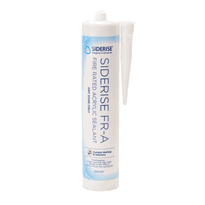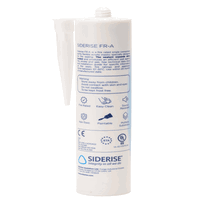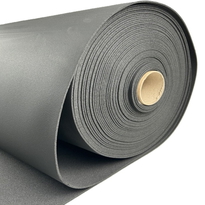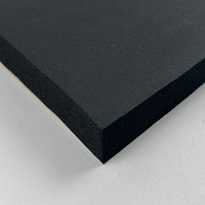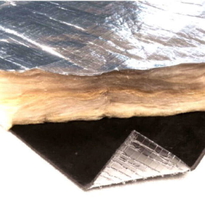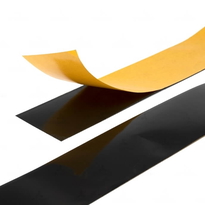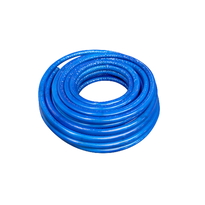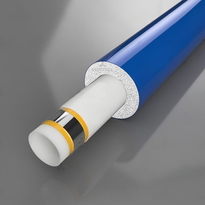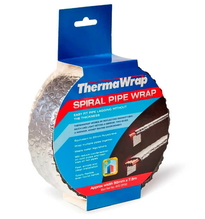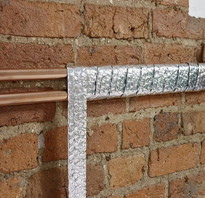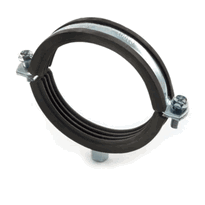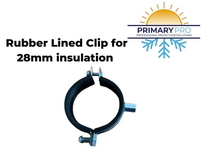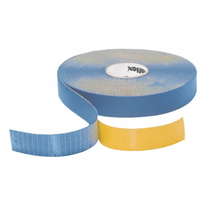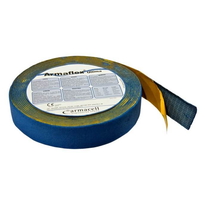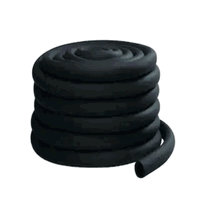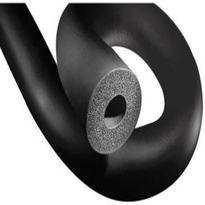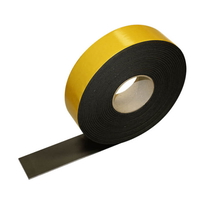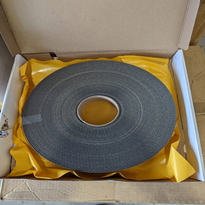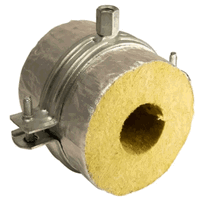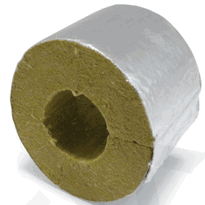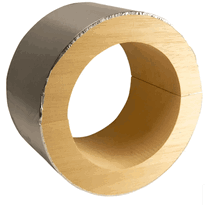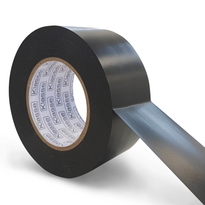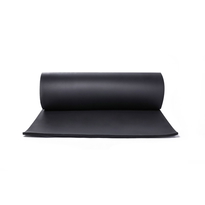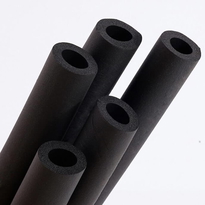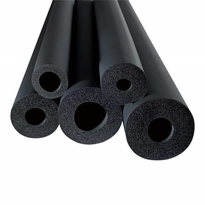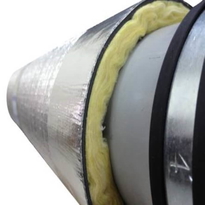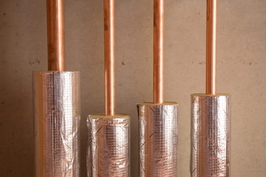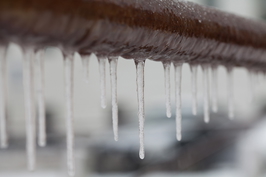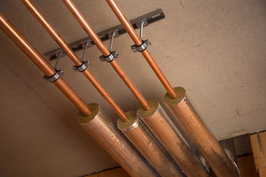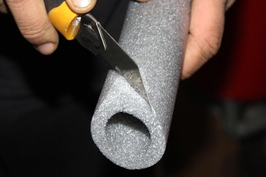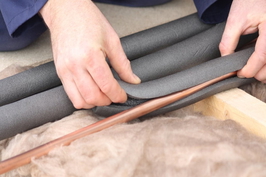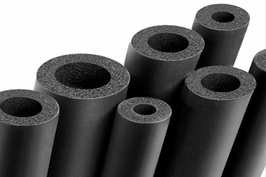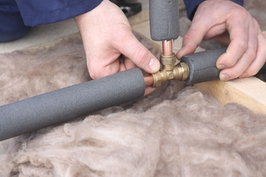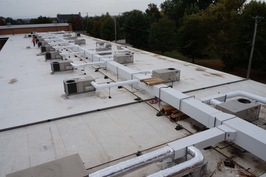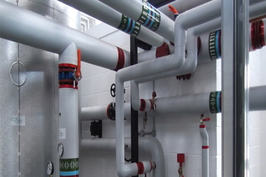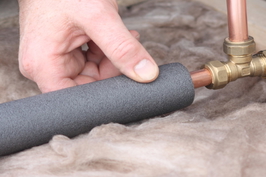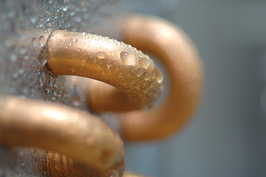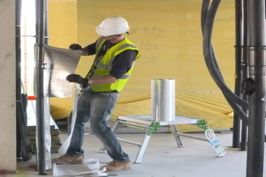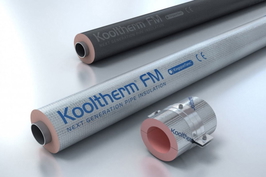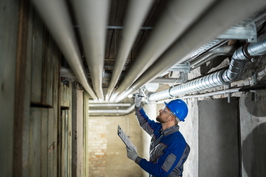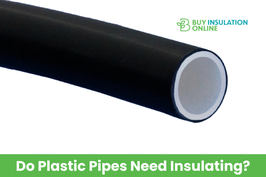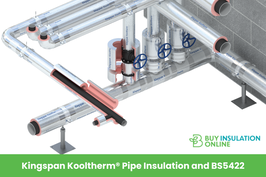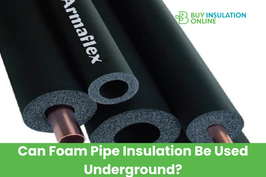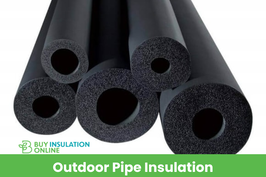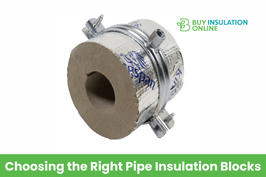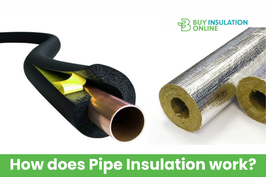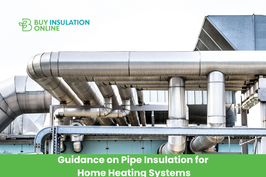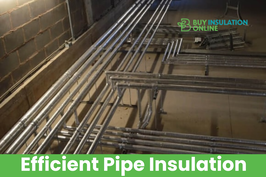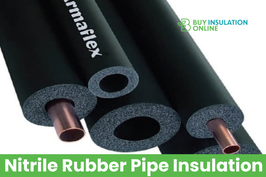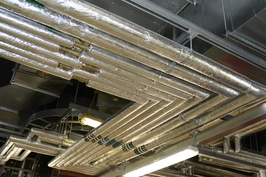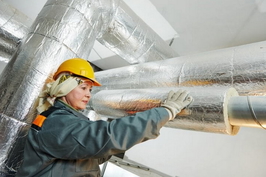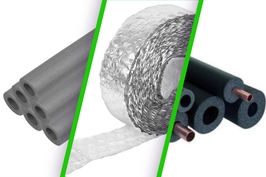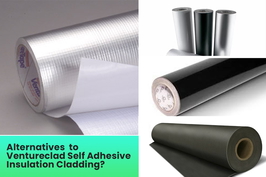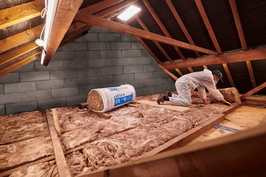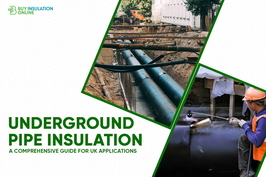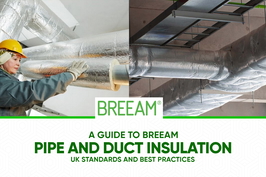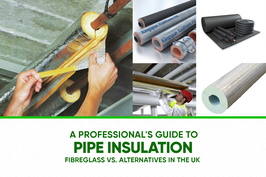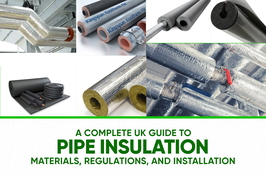2m Pipe Insulation
Pipe insulation comes in various materials such as polyethylene foam, rubber, and foam boards, offering options suited for different temperatures and environments. These insulations vary in thickness, moisture resistance, and acoustic properties, with some specifically designed for outdoor use or high-temperature applications.
Pre-slit and self-sealing types simplify installation and ensure a snug fit. Selecting the appropriate insulation depends on your specific needs, and further exploration can reveal ways to optimise performance for your system.
Types of Materials Used in 2m Pipe Insulation
There are several common materials utilised for pipe insulation, each offering distinct advantages depending on the application. Polyethylene foam insulation is lightweight, flexible, and resists moisture, making it ideal for plumbing, heating, and cooling systems in homes. It also effectively reduces noise from fluid movement within pipes. Polyisocyanurate (PIR) foam insulation provides high thermal efficiency and fire resistance, making it suitable for industrial settings where high temperatures are prevalent. Polyurethane foam is known for its excellent insulation properties and durability, often employed in refrigeration systems. Fibreglass and mineral wool insulations are more appropriate for high-temperature environments and offer fire resistance, frequently found in commercial or industrial applications. Rubber-based insulations, such as nitrile rubber, are flexible, moisture-resistant, and suitable for both indoor and outdoor use, particularly in HVAC systems. Proper insulation selection can significantly impact overall energy consumption and operational safety. Selecting the right insulation material is crucial for ensuring energy efficiency and safety in various settings.
Variations in Lengths and Thicknesses for 2m Insulation Tubes
Insulation tubes for pipes are available in a range of lengths and thicknesses to cater to various installation needs. The standard length of 2 metres is particularly popular due to its ease of handling, transportation, and installation, making it a preferred choice for both professionals and DIY enthusiasts in the UK.
Some manufacturers provide specialised options, including longer coils or shorter lengths for specific applications such as HVAC systems. While these tubes are typically sold unsplit, semi-split versions may also be available for easier fitting around pipes.
Thicknesses of insulation tubes vary significantly, generally ranging from 10mm to 50mm or more, depending on the insulation requirements and the size of the pipe.
Thicker walls offer enhanced thermal protection, making them ideal for outdoor or high-temperature pipes. This variety allows for versatile options suitable for different environmental conditions and insulation needs.
Thermal Performance and Suitability for Different Temperature Ranges
Understanding how well pipe insulation performs at different temperatures is essential for selecting the appropriate material for specific applications. Various insulations excel within particular temperature ranges, ensuring energy efficiency and safety.
Phenolic foam insulation is highly effective within a temperature range of -50°C to +110°C, providing excellent thermal efficiency with low thermal conductivity. These characteristics make it suitable for both cold and moderate hot environments.
Elastomeric rubber insulations, such as Armaflex, can manage higher temperatures, reaching up to +150°C, making them ideal for hot water systems and HVAC applications. Temperature resistance of certain materials is critical for their performance in thermal management.
Materials like polyethylene foam or nitrile rubber are commonly chosen for lower temperature environments, offering good thermal resistance and moisture protection.
The selection of insulation depends on the conditions: phenolic foam is resistant to high heat and flames, while rubber foams are more suitable for outdoor use where UV exposure is a concern.
Proper selection enhances both performance and safety.
Moisture Resistance and Outdoor Application Considerations
Moisture resistance is a crucial consideration when selecting pipe insulation for outdoor applications. Materials such as EPDM foam rubber provide excellent moisture barriers, effectively preventing water vapour from penetrating and minimising condensation on pipes. This protection plays a vital role in stopping corrosion and mineral build-up, thereby extending the lifespan of the pipe. EPDM rubber's durability ensures that the insulation remains effective even under harsh weather conditions. Seam closures, including dual tape or Protape, enhance moisture barriers at joints, preventing water ingress. Additionally, built-in vapour barriers like polyethylene foam contribute to keeping moisture at bay. For outdoor use, it's essential to choose insulation that offers UV and weather resistance, ensuring it can withstand sun exposure, rain, and temperature fluctuations. Certain products are formulated with antimicrobial additives to deter mould growth. Proper installation features, such as self-sealing seams and robust materials, further enhance durability in outdoor settings. This comprehensive approach guarantees long-lasting, moisture-protected pipe systems, essential for effective outdoor performance.
Acoustic Insulation Capabilities of 2m Pipe Insulation
The effectiveness of 2m pipe insulation in reducing noise largely depends on the materials utilised and the quality of installation. Various types of insulation, such as mineral wool or foam, play a significant role in how efficiently sound is dampened. Material choice greatly influences acoustic performance. By understanding these factors, individuals can make informed decisions when selecting the appropriate insulation to minimise noise transmission. Proper installation is crucial, as even the best materials can underperform if not fitted correctly. When considering acoustic insulation, it's essential to evaluate the specific needs of your environment to choose the most suitable option. Investing in high-quality pipe insulation can lead to a noticeable reduction in sound, enhancing comfort and tranquillity in residential and commercial settings alike.
Sound Dampening Efficiency
Sound reduction is a crucial characteristic of pipe insulation, and its effectiveness is influenced by several factors, including the choice of materials and construction techniques. Well-designed insulation can greatly diminish noise transmission through pipes.
The following aspects significantly affect sound dampening efficiency:
The incorporation of mass-loaded vinyl and decoupler layers enhances sound blocking capabilities.
Thicker insulation options provide improved noise attenuation.
High-density mineral wool effectively absorbs both airborne and structure-borne noises.
Ensuring full coverage with flexible sheet formats helps to minimise sound leaks at joints and connections.
These construction elements, aligned with established standards, guarantee that insulation achieves consistent performance levels.
When correctly installed, pipe insulation can successfully reduce unwanted noise, fostering quieter and more comfortable environments while upholding safety and functionality.
Material Influence on Noise
Different materials utilised in pipe insulation vary in their ability to mitigate noise, influencing how effectively they obstruct sound transmission.
Polyethylene foam, such as Armacell Tubolit, absorbs vibrations from fluid movement, minimising noise within pipes.
Elastomeric foam, like K-FONIK GK, provides high-density dampening due to its viscoelastic properties, which effectively reduce both airborne and structure-borne noise.
Mineral wool and fibreglass insulations trap sound waves within their dense, fibrous structures, delivering exceptional sound absorption.
Mass-loaded vinyl, when combined with foam layers, adds mass and decouples vibrations, further containing noise.
Thicker insulation layers and high-density materials enhance soundproofing capabilities.
Density and thickness are key factors in determining the acoustic insulation performance of pipe insulation materials.
Environmental Impact and Eco-Friendly Insulation Options
Enhancing the environmental impact of pipe insulation necessitates the selection of eco-friendly materials and the refinement of installation techniques to reduce energy consumption and emissions.
Sustainable insulation choices, such as fibreglass, rock wool, and slag wool, provide both thermal efficiency and significant environmental advantages. Adopting these materials can lead to a considerable decrease in carbon dioxide emissions and energy waste.
Key approaches to improve sustainability include:
Using the appropriate insulation thickness, which can significantly reduce heat loss, thereby conserving energy.
Implementing environmentally responsible insulation materials, which effectively lower CO2 emissions.
Expanding insulation regulations can lead to substantial savings in natural gas and electricity usage on an annual basis.
Choosing factory-pre-insulated pipes can help minimise waste and support an eco-friendly system design.
These practices foster a sense of community by contributing to a cleaner and healthier environment for everyone.
Advantages of Pre-Slit and Self-Seal 2m Insulation Tubes
Pre-slit and self-seal 2m insulation tubes provide significant advantages that can enhance the installation process and overall system performance.
These tubes are factory-cut with precise slits, eliminating the need for measuring and cutting on site. This not only streamlines the installation but also minimises the time required for completion. Pre-slit design allows for more accurate fitting around pipes, ensuring consistent thermal coverage and reducing gaps.
The self-seal adhesive allows for secure closure of the tubes without the need for additional fasteners or glue, leading to savings in both labour and costs.
The robust double bonding, featuring internal mesh tape and overlapping self-adhesive surfaces, ensures durability, particularly at seams.
Thanks to their ready-made lengths and straightforward sealing methods, these insulation tubes facilitate quicker installation around pipes and fittings.
Such features contribute to a neater, more professional finish, ensuring improved consistency and long-term protection against moisture and environmental damage.
Selecting the Right 2m Pipe Insulation for Specific Systems
Selecting the appropriate 2m pipe insulation is crucial and should take into account compatibility with various materials, the temperatures the system will encounter, and environmental factors such as moisture. The insulation materials must be suited to the specific type of pipe and its intended use to ensure safe and efficient operation. Different insulation types offer varying levels of thermal resistance, making it essential to match the insulation to the specific application. When choosing insulation, it's important to consider durability and local climate conditions to prevent damage and maintain the performance of the insulation over time.
Material Compatibility and Use
When selecting a 2-metre pipe insulation, it's essential to understand each material’s compatibility with the system to ensure safety, efficiency, and durability.
Various materials are suited to specific applications based on their distinct properties:
K Flex Pipe Insulation is ideal for systems that require sound dampening and thermal efficiency.
Armacell Tubolit Polyethylene Foam is well-suited for damp environments due to its low thermal conductivity and moisture resistance.
Rockwool Pipe Insulation excels in high-temperature and fire-safe systems, given its non-combustible nature. It is rated A1 or A2 under fire classification standards.
Armaflex Nitrile Rubber is favoured where flexibility and fire resistance are key, particularly in plumbing and HVAC applications.
Choosing the appropriate material is crucial for aligning insulation properties with system requirements, ultimately ensuring longevity and safety for users.
Temperature and Climate Suitability
Choosing the appropriate 2-metre pipe insulation is significantly influenced by the temperature and climate conditions of the installation environment. Different materials are tailored to suit various conditions, thereby ensuring optimal performance.
For instance, K-FLEX ST is effective in very low to moderately high temperatures, making it ideal for both refrigeration and hot water applications. In contrast, Micro-Lok HP requires modifications to accommodate high-temperature environments, particularly in industrial settings. For extremely cold conditions, Styrofoam XPS is recommended, as it performs well in very low temperatures and moisture-prone areas. Mineral fibre insulation is robust enough to handle high temperatures, making it suitable for industrial uses. Cellular elastomer insulation is versatile, functioning effectively across a wide range of temperatures.
Material
Temperature Range
Best Use Cases
K-FLEX ST
Very low to moderately high temperatures
Heating, cooling, hot water pipes
Micro-Lok HP
High temperatures (with adjustments)
High-temperature industrial piping
Styrofoam XPS
Very low temperatures
Low temps, moisture-prone areas
When selecting insulation, it is essential to consider the specific requirements of your project. The right choice will ensure efficiency and longevity in your piping systems.
Moisture Resistance and Durability
Moisture resistance and durability are crucial considerations when selecting the appropriate 2-metre pipe insulation for various systems. Insulations composed of closed-cell structures inherently resist water absorption, which helps to maintain thermal efficiency and strength over time.
High vapour diffusion resistance further limits moisture penetration; for instance, certain insulation options offer substantial still air resistance with minimal thickness.
Rubber insulation serves as an effective moisture barrier by sealing gaps and preventing dampness, while moisture-resistant materials help to mitigate the risks of mould growth. Furthermore, these materials retain their thermal properties even in humid conditions.
Durability is influenced by factors such as protection against water damage, UV exposure, and mechanical wear.
Choosing the right insulation ensures a longer lifespan for the system, reduces maintenance requirements, and preserves efficient operation despite environmental challenges.
Conclusion
Choosing the right pipe insulation is crucial for effective thermal performance and energy efficiency. The selection of insulation material, size, and application requirements plays a significant role in enhancing temperature control and moisture resistance, making it suitable for a range of environments.
Various options are available, including pre-slit insulation, which offers ease of installation, and eco-friendly products that prioritise sustainability. Selecting the appropriate insulation ensures optimal performance and longevity for diverse piping systems.
Understanding these factors enables users to make informed decisions, ensuring they reap the full benefits of pipe insulation while contributing to energy conservation and environmental responsibility. With the right choice, you can maximise the efficiency and durability of your piping solutions.












